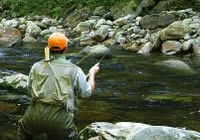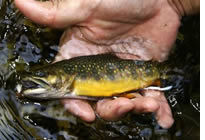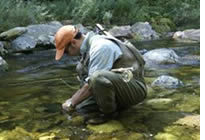Written by Tom Rosenbauer
 It might surprise most fly fishers to find out that the number of fellow anglers in this country is not growing by leaps and bounds; in fact it is hardly growing at all. It is just that a finite number of anglers gets pushed around from one great spot to another at prime time, local people who bemoan the vast hordes of yuppies cluttering up their long-treasured secrets should blame the Internet more than A River Runs Through It. News of a great hatch on the Bighorn can be around the world in a matter of hours. Still, all of us yearn for a stream of our own, a place visited by only a few other fly fishers each season, where the tight feeling in your chest when you round the bend to check if anyone is in your favorite pool could be banished. You can find such a spot and it might be closer to home than you think.
It might surprise most fly fishers to find out that the number of fellow anglers in this country is not growing by leaps and bounds; in fact it is hardly growing at all. It is just that a finite number of anglers gets pushed around from one great spot to another at prime time, local people who bemoan the vast hordes of yuppies cluttering up their long-treasured secrets should blame the Internet more than A River Runs Through It. News of a great hatch on the Bighorn can be around the world in a matter of hours. Still, all of us yearn for a stream of our own, a place visited by only a few other fly fishers each season, where the tight feeling in your chest when you round the bend to check if anyone is in your favorite pool could be banished. You can find such a spot and it might be closer to home than you think.
There are no more secret medium-to large-sized trout streams. They lie exposed to easy casting, publicity, and tradition. Small streams are where you’ll find a place of your own. The easiest to find are the smaller branches of major trout streams. As you climb up the trunk and into the narrower limbs, crowds and other annoyances like canoes and inner tubes dissipate. Your chances of finding a huge trout decrease, but most often the sheer number of trout per square foot of stream increases dramatically. An adult trout can thrive in a pool the size of a large coffee table as long as at least part of this pool is over 2 feet deep or one edge of the pool has a log or rock they can use when danger threatens.
 I often drive along one of my favorite streams with another fisherman and casually ask “Would you fish that?” “Naw, looks too small and brushy” is the usual answer and I put on my best poker face (which the Wednesday night crew will tell you is not too good) and agree. It’s almost axiomatic that streams like this look shallower from the car, and until you get off your butt and wade them that you see how deep the pools are, and you see that by working directly upstream you can get as much as a 30-foot cast, which is more than you need on a tiny stream. I have also found that by hiking upstream or downstream on these trickles, the streamside brush and the size of the pools open up. One such river near my house looks impossibly small from the road but if you bother to hike upstream 50 yards you’ll find a waterfowl pool that is 50-feet wide and 6 feet deep. It holds plenty of trout as long as the skinny dippers haven’t frightened them for the day.
I often drive along one of my favorite streams with another fisherman and casually ask “Would you fish that?” “Naw, looks too small and brushy” is the usual answer and I put on my best poker face (which the Wednesday night crew will tell you is not too good) and agree. It’s almost axiomatic that streams like this look shallower from the car, and until you get off your butt and wade them that you see how deep the pools are, and you see that by working directly upstream you can get as much as a 30-foot cast, which is more than you need on a tiny stream. I have also found that by hiking upstream or downstream on these trickles, the streamside brush and the size of the pools open up. One such river near my house looks impossibly small from the road but if you bother to hike upstream 50 yards you’ll find a waterfowl pool that is 50-feet wide and 6 feet deep. It holds plenty of trout as long as the skinny dippers haven’t frightened them for the day.
You don’t always have to go to the very top of the system, of course. Sometimes you’ll find a small tributary that no one bothers with well down in the course of a famous river. My advice is to skip the first hundred yards, as most people try a few casts off the main river and then give up. Persistence will pay off. Don’t rule out irrigation ditches, either. Trout get sucked into irrigation systems and some of them are almost like spring creeks. One of my best evenings of trout fishing in California was in an irrigation ditch in the Fresno raisin country.
 A word of caution: Little streams look notoriously fishy at high water and the realities of mid and late-season water levels can be disappointing. Just walking the banks won’t tell you much unless you happen to hit one at a rare time when there is a hatch of insects and the fish are rising. Small stream trout are remarkably talented at hiding their presence, seeing or sensing your presence long before you can see them and bolting under the nearest flat rock or log, rather than bolting upstream through a pool where they can be spotted. When I was a kid I found them either by poking along the undercuts in meadow streams with a stick or (gulp) worming them. Better yet is to fish them in prime time—late May to early June in the East and before or after runoff in the West.
A word of caution: Little streams look notoriously fishy at high water and the realities of mid and late-season water levels can be disappointing. Just walking the banks won’t tell you much unless you happen to hit one at a rare time when there is a hatch of insects and the fish are rising. Small stream trout are remarkably talented at hiding their presence, seeing or sensing your presence long before you can see them and bolting under the nearest flat rock or log, rather than bolting upstream through a pool where they can be spotted. When I was a kid I found them either by poking along the undercuts in meadow streams with a stick or (gulp) worming them. Better yet is to fish them in prime time—late May to early June in the East and before or after runoff in the West.
When you do find one of these gems, leave your tip flex or fast action rods at home. Casts are very short, often just a few feet of fly line. You need a full-flex action to straighten the leader with these short casts—plus it’s just more pleasant when you feel the rod bending. The Superfine Trout Bum rods or a classic bamboo rod are the sticks designed for this kind of fishing. Do you need a super-short rod? It really depends on the size of the stream, and whether you have room behind and in front of you. With meadow streams, you can get away with an 8-foot rod and sometimes need one to keep your casts out of low brush along the river. In some mountain streams, trees don’t grow right up to the banks so you can get a 20 or even 30-foot cast behind you as long as you are casting straight upstream. But when you venture into the true wooded gems that most people walk by, you’ll be happier with a 6 1/2 or 7-foot rod that will fire a bushy dry under streamside brush with ease.







